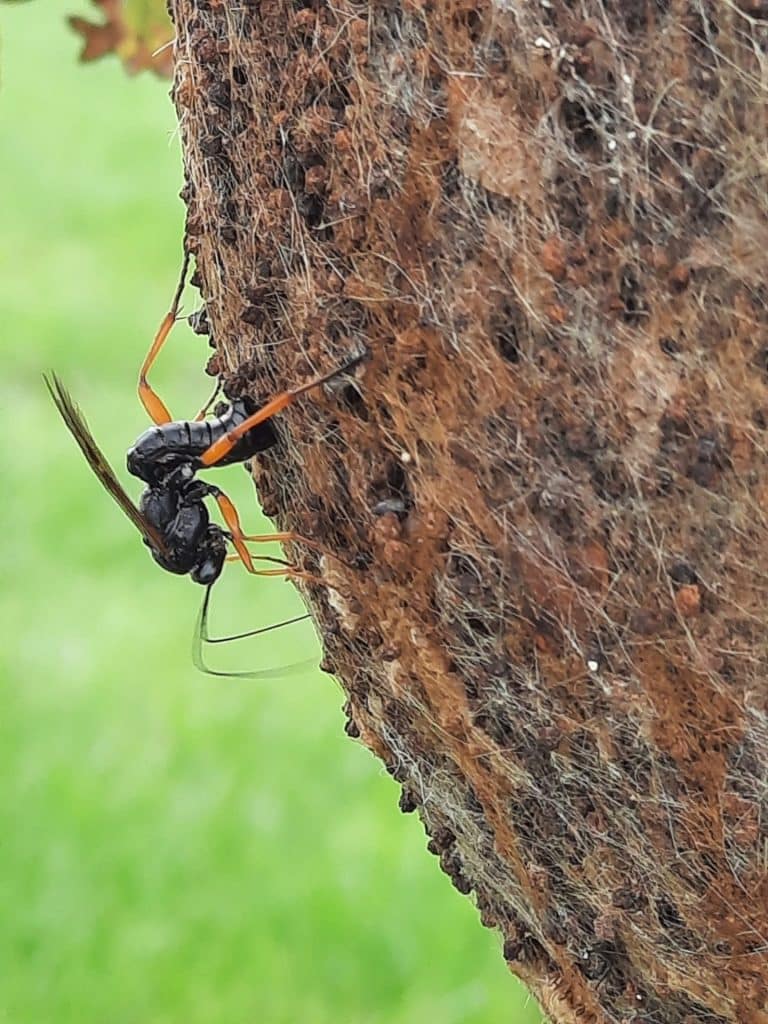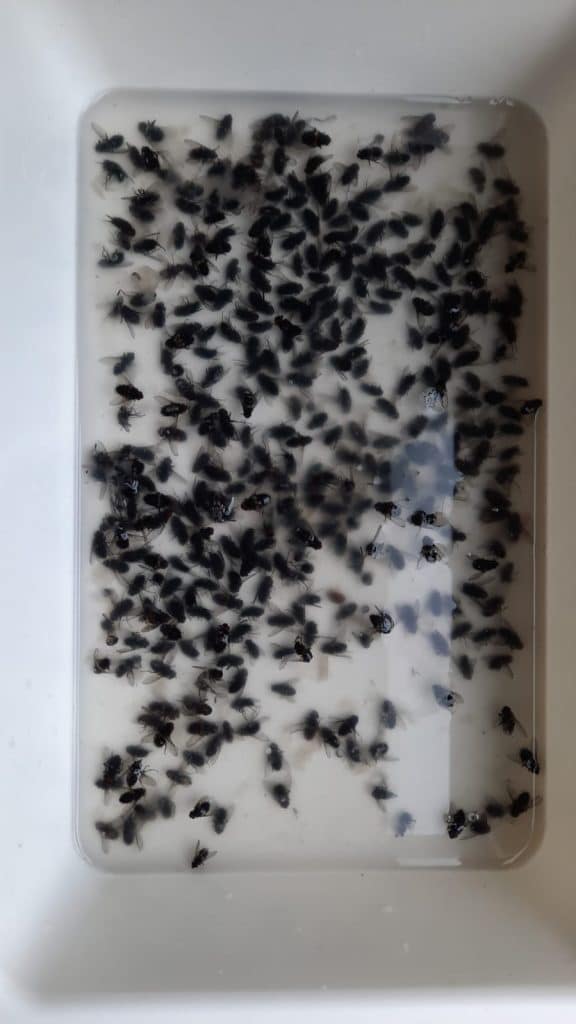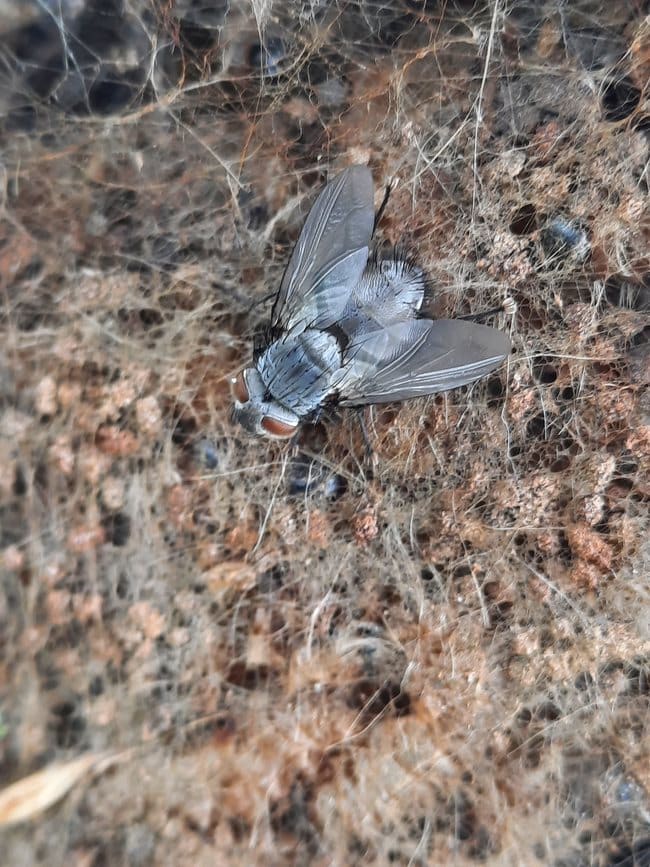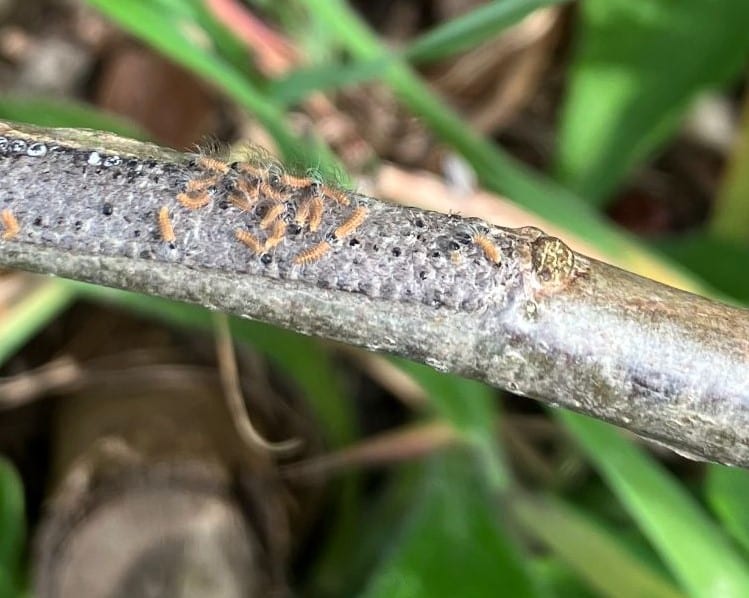Spring is in the air, there are the caterpillars…
And what about the oak processionary caterpillar this year? That is currently the key question for many local governments.
It is expected that they will not be as numerous this year. Due to the rainy summer of 2022, few butterflies reached adulthood and were therefore unable to lay many eggs. This year we have also seen a cold spring so far, many oaks were only just getting leafs at the beginning of May. During the field research with an aerial work platform, Toon and Joost found relatively few caterpillars. Good for public health, less good news for our experiments, such as those with the tits, the forrest caterpillar hunter and the parasitioid flies and wasps
Mid-term Conference – Postponed, not cancelled
We have postponed the planned presentations of our interim results on 20/04 to a better time. During this meeting we want to inform policymakers in the Netherlands and Flanders about new, more ecologically responsible management techniques for the oak processionary caterpillar, in order to contribute to reducing the use of biocides.
Unfortunately, we received few responses to our invitation. That is why, before we complete a new edition, we listen to you with a short survey. With the answers we will start organizing a new meeting at the end of September or the beginning of October. So complete our short survey and keep an eye on your mailbox and the website!
Forest Caterpillar Hunter-experiment: Looking for other solutions
The forest caterpillar hunter (Calosoma sycophanta) is a ground beetle species from which quite a lot is expected. It specializes in eating hairy caterpillars, and apparently it is not bothered by the stinging hairs that the caterpillar is feared for. The beetle was considered extinct in Belgium and the Netherlands – until it was suddenly spotted again in dozens of places last year. A consequence of the increased attention as a result of the project?

In the spring of 2022, we received several hundred eggs and adults of the forest caterpillar hunter from the Turkish General Directorate of Forestry, i.e. the Forestry Commission in Turkey. The beetle has been used there for years in the fight against the pine processionary caterpillar, a close cousin of our oak processionary caterpillar. The animals spent the entire previous summer, autumn and winter in our breeding cages underground and became active again at the beginning of last month. About half of the Turkish beetles survived our – for them – cold and wet winter period, which can be called a reasonable success. Unfortunately, they woke up long before the first oak processionary caterpillars appeared. So for the time being they are fed earthworms and larvae of the greater wax moth, waiting for the moment when our oak processionary caterpillars are large enough to arouse their interest.
It is clear that the animals we are now trying to breed are not suitable in our fight against the oak processionary caterpillar and will never be released into the wild – their natural biorhythm, adapted to the pine processionary caterpillar, does not allow this. In addition, due to possible undesirable impact on population genetics, it is not responsible to release these animals in areas where they are already naturally present. Don’t worry, because there are other options. In Turkey there are also populations of the forest caterpillar hunter that have specialized on the oak processionary caterpillar and are probably better suited for our breeding trials. And closer to home, such as in Germany and the Grand Duchy of Luxembourg, the beetle has now also been able to form sustainable populations that can form a possible source for a breeding program. The breeding experiment will therefore be continued this year with some adjustments and new animals.
In addition, this spring we also want to visit some of the locations where the species reappeared last year after years of absence, in the expectation of learning what type of habitat this beautiful beetle species prefers.
Road Verge Management Experiment: Promising results with the parasitoid flies
The parasitoid flies and wasps spent the winter as larvae in last year’s caterpillar nests and are now flying out, ready to look for new caterpillars to deposit their eggs. The Limburg team, Luc and Toon, carefully monitors how many flies and wasps hatch from each caterpillar nest and then calculates what percentage of the caterpillars have been parasitized. The results of the first year of research were promising, as you could read in a previous newsletter – on average 67% of the caterpillars at our test locations are killed by parasitic flies and parasitic wasps. The 2022 results are still being finalized but should be clear by the interim conference. Since this method seems to have the most potential so far, we will certainly explore this research further.



The most important question we still have to answer is how we can make the flies as comfortable as possible, so that they parasitize as many caterpillars as possible. A lot depends on the quality of the verges around the oak trees. The parasitic fly larvae are satisfied with tender caterpillars, but the adult flies also need nectar, moisture and/or shelter, which they look for near the nests.
So we would like to know which type of road verge vegetation and which plant species are most interesting in this control method. However, the division into six verge types that we have used so far does not appear to provide an unambiguous answer to that question. A different approach is therefore necessary. That is why we are re-examining the vegetation recordings from the past two years, with more attention to detail and even down to species level. We tackle the mass of information that we then collect with various statistical methods. We expect this to lead to one or more types of verges and combinations of plant species that are most appreciated by parasitoid flies and wasps.
